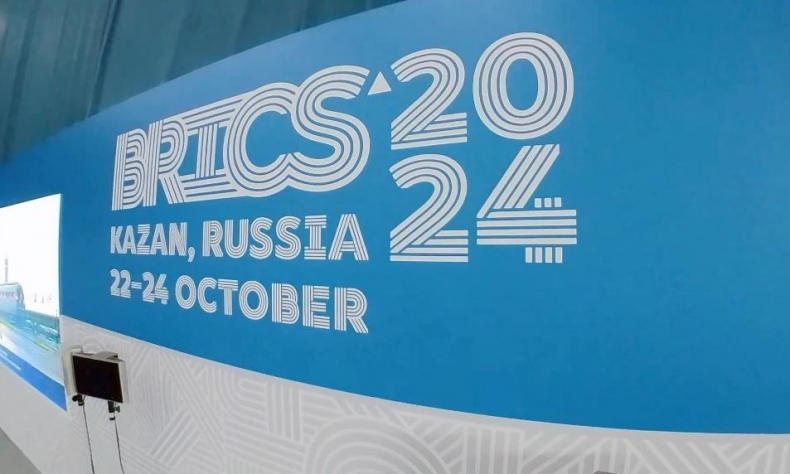Broader, Golden Prospects

BRICS countries should fully leverage the new circumstances of the group’s expansion and the agenda set at the 2024 summit in Kazan, Russia, to achieve more across supply chains, trade and finance. This will effectively counter external interference and continue to shape new dynamics.
This year is a milestone for economic and trade cooperation among BRICS countries. The group of emerging economies, originally consisting of Brazil, Russia, India, China and South Africa, welcomed new members in January, opening up new opportunities and possibilities for the future.
However, given the still complex and volatile international situation, the group must jointly address challenges to shape new momentum.
Opportunities
With the expansion, BRICS countries now account for 46 percent of the global population and 30 percent of the global GDP—the total value of all the goods and services produced in one year. A larger population and market further consolidate the foundation for BRICS cooperation and increase potential benefits of participation.
The space for cooperation on energy resources among BRICS countries has been expanded. The new members have abundant energy and mineral resources. BRICS’ share of global crude oil production has now been increased by 21 percentage points to 42 percent, and natural gas production rose by 12 percentage points to 36 percent.
In addition to oil and gas resources, new members also boast rich mineral and natural resources. This will provide the group with more diverse raw materials for internal industrial cooperation.
As a result of the new nations joining, the share of BRICS countries in global trade in goods has increased by 5 percentage points to the current 25 percent. Moreover, from low-end raw materials to mid-to-high-end manufacturing, BRICS has enhanced the resilience of its industrial and supply chains through further integration among members.
More industrial innovation collaboration among BRICS countries is also unfolding, as the new members possess unique advantages in diverse technological fields. The United Arab Emirates (UAE) has advanced technological capabilities in petrochemicals and aerospace, while Egypt has experience in technological transformation in traditional industries like textiles and steel. Iran has extensive research and development (R&D) capacities in nuclear energy and oil exploitation, while Ethiopia is a major innovation hub for manufacturing on the African continent. All these technological advantages have enhanced the overall scientific and technological strength of BRICS, further consolidating and expanding BRICS partnership on the new industrial revolution.
The expansion also provides BRICS with broader market and investment opportunities. Deepening trade and investment cooperation among its members will help BRICS enterprises expand their markets as well as increase market share. Together, the group can better shape the agenda and future of global economic and trade cooperation, thereby gaining a greater voice and influence in the international arena.

Addressing common challenges
The increase in the number of BRICS members and the evolving geopolitical landscape present a new set of circumstances and challenges.
Coordination and integration should be strengthened within the group. The five original members have established relatively stable cooperation mechanisms. The addition of new members necessitates adjustments and restructuring of the existing framework. Differences in resource endowments, varied policy concerns and interest divergences among members become more prominent, increasing the costs and difficulties of communication, coordination and integration.
Member countries should jointly address the deficit of global public goods. To provide institutional guarantees for coordinating economic and trade policies and deepening cooperation, BRICS needs to offer more extensive and targeted arrangements as public goods. Besides, with their increased influence in global economy and trade, member countries need to play a more vital role in promoting trade and investment facilitation and global economic democratization to meet the international community’s expectations.
BRICS advocates equality, with each member having an equal voice. However, the majority of new members have relatively small economies and trade scales, making it hard for all to equally fulfill their responsibilities and obligations. Economic powerhouses may need to invest more resources and funds in support.
After the expansion, Western countries will pay more attention to BRICS cooperation and may be concerned about the group uniting to challenge their established international economic status and global influence. They might even introduce measures to interfere with and obstruct BRICS collaboration. Therefore, BRICS nations must increase efforts to prevent external forces from sowing discord among them.
Shaping new dynamics
BRICS countries should fully leverage the new circumstances of the group’s expansion and the agenda set at the 2024 summit in Kazan, Russia, to achieve more across supply chains, trade and finance. This will effectively counter external interference and continue to shape new dynamics.
Energy and food sectors have the potential to be growth drivers for greater BRICS cooperation. Members can align their food supply and consumption needs to form a trading system, facilitating the liberalization and convenience of related trade among members, thus building a secure and stable BRICS food supply chain.
Utilizing the energy reserves and transition demands of members like the UAE and Iran, the BRICS family can forge closer energy partnerships among members, enhancing the efficient use of traditional energy and reshaping the clean energy supply chain. This would further increase BRICS influence in global energy and climate governance.

Closer innovation collaboration in hi-tech industries such as artificial intelligence (AI), 5G, new energy and aerospace should be anticipated, with the members jointly driving breakthroughs in key, common, cutting-edge and disruptive technologies. Within its framework, BRICS nations can establish a joint AI research group to explore both opportunities and impacts of related technologies on economic growth and work together to build a BRICS AI governance framework and regulatory standards.
They can establish bilateral and multilateral research centers, co-build R&D laboratories and technological parks, concentrate advantageous resources, and promote technology transfer and incubation to improve R&D efficiency, reduce costs, and foster the integration and progress of emerging industries in BRICS countries.
Members should deepen monetary and financial cooperation to provide a favorable environment. They can establish a stable currency swap mechanism among them to reduce the impact of exchange rate fluctuations on their domestic enterprises. They can increase the size of the foreign exchange reserves pool to enhance collective responses to possible international financial and liquidity crises.
BRICS countries need to further develop local currency bond markets, encouraging member governments, financial institutions and large multinational enterprises to issue local currency bonds. Taking BRICS member currencies as important base currencies, they can push for a settlement system based on blockchain and digital currency technologies.
Members should also strengthen cooperation in traditional industries such as agriculture, textiles, steel and automobiles as well. The resources, markets and technologies of each member can be integrated through jointly established industrial and business parks. This will promote the optimization and technological upgrading of traditional industries, orderly advancing industrial transfer, market expansion and division of labor among BRICS countries.
Taking into consideration the established mechanisms such as the New Development Bank, broader areas of joint efforts are expected. With the addition of capital-rich new members, the New Development Bank’s capacity to provide loans to developing regions will also increase. In addition to continuing to invest heavily in infrastructure and green development, the bank should participate in building the BRICS partnership on new industrial revolution, and fostering an open, fair and non-discriminatory environment for technological advancement.
The author is a senior research fellow with the National Academy of Chinese Modernization, Chinese Academy of Social Sciences.
 Facebook
Facebook
 Twitter
Twitter
 Linkedin
Linkedin
 Google +
Google +










